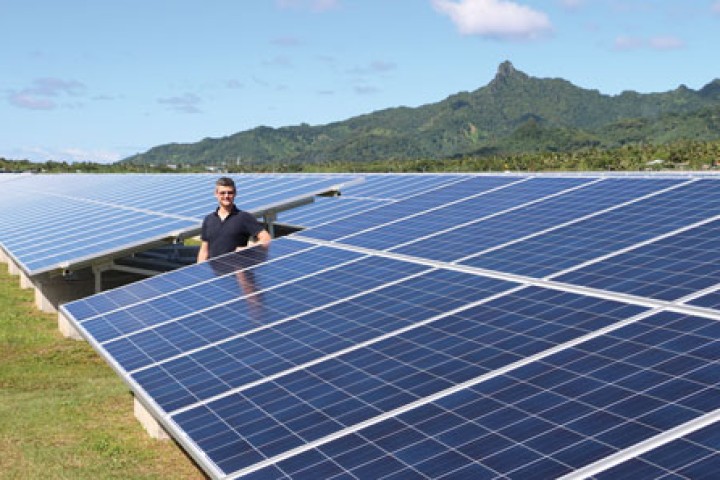A Renewable Energy Journey in the Pacific

The pursuit of high penetration of renewable energy in the Pacific involves good planning and skilled navigation to stay safe and on course, and holds the promise of rich rewards.
Throughout the Pacific, island communities are embracing ambitious renewable energy targets, many as high as 100 percent over the next decade or two. This isn't surprising, given that these islands are already experiencing significant climate change impacts, and recognize the environmental benefits of reducing or replacing carbon-intensive diesel power generation.
There are also sound economic benefits to reducing reliance on expensive diesel fuel, which remains the single largest expense for power generation in these remote locations.
The answer to meeting targets, while also reducing carbon emissions and costs, lies in power systems that use only renewable energy. However, transitioning to higher levels of renewable energy in power systems requires confidence that the renewables can provide the energy security, self-sufficiency and system stability required by these remote communities.
Renewable energy technologies may pose some challenges for reliability and quality of power supply, but remedies can be found in enabling technologies. In an isolated power system, matching the renewable technologies with the right enabling technologies at the right moment needs detailed planning.
Every Journey Needs a Map
Entura has been helping a number of Pacific island communities embark on their renewable energy journeys. Through this experience, we've developed a map of the key stages of the journey:
Stage 1: Planning - Explore the status of current power generation assets, determine what needs to be improved, understand the renewable resource, and investigate the cost and options for funding it.
Stage 2: Begin harvesting the 'low-hanging fruit' - introduce renewables that will work without enablers or network upgrades, and without changing the control philosophy. At this stage, renewables are used to mostly load offset, and could reach up to 20 percent of the island's total energy demand.
Stage 3: Expand - To progress toward 35 percent, we need to adjust the system's operating philosophy to integrate large-scale renewables, and introduce the appropriate enabling technologies.
Stage 4: Enable - This stage marks the largest change in how the island power system is operated. To move beyond 50 percent renewables, we stop, review, and adjust course where needed. At this stage, power systems become very complex to operate and maintain because high renewable penetration can only be achieved through a delicate balance of multiple new enabling technologies working in sync. The island community could find itself investing more in enabling technologies than in renewable energy at this stage, but this could result in a higher renewable energy contribution. It is also crucial to consider changes to energy delivery, the utility's relationships with customers and its procedures, and to building its personnel capabilities.
Stage 5: Finishing the journey - The 'last renewable mile' is usually the most expensive one, so this last stage means identifying enabling technologies and techniques that can bridge the gap between 70-80 percent and 100 percent renewable contribution, without significant increases in the cost of electricity.
Yap's Journey to 25 Percent Renewables
Yap State Public Service Corporation wanted to reduce Yap's heavy reliance on imported diesel for power generation and enable the island to rely as much as possible on indigenous, renewable resources through an integrated high-penetration renewable energy remote area power system (RAPS).
After decades of operating on diesel only, the system will soon reach 25 percent renewable energy contribution. Once completed, the goal is to enable Yap to experience up to 70 percent instantaneous renewable penetration when conditions allow, and to deliver an annual fuel saving of up to US $500,000.
Entura began working Yap in 2014 to help plan its renewable journey by embarking on Stage 1. Since then, the company has helped the Yap utility to reach Stage 2 by integrating small amounts of solar and by building its capability to install and maintain solar arrays.

The Yap renewable energy development project is now entering Stage 3. Major undertakings at this stage include installing a new breed of high-renewable-supporting diesel generators; three 275-kW cyclone-proof wind turbines; an island-wide solar-controlling communications network for 500-kW distributed solar PV; and a centralized control system.
On Course for 100 Percent Renewables In The Cook Islands
The Cook Islands is a group of 15 small islands in the South Pacific, northeast of New Zealand. Entura is helping the Cook Islands to reduce reliance on diesel fuel and achieve greater energy security, self-sufficiency and sustainability through developing renewable power systems on six islands. The country's goal is 100 percent renewable energy by 2020.
The islands of Mauke, Mitiaro, Mangaia and Atiu have small average loads of around 100 kW each. After careful planning, upgrades to the distribution grid and programs to train and build local capacity, these islands will quickly reach Stage 5 of their journeys, operating at almost 100 percent renewable energy using solar PV and batteries, with diesel providing backup during longer periods of renewable energy resource deficiency.
A fifth island, Aitutaki, is currently at Stage 1, finalizing the planning of its renewable journey. It will rapidly jump to Stage 3 as 1 MW of solar PV, a 0.5 MW power battery, new diesel generator and centralized control system start working together to deliver a power system with a renewable contribution of up to 25 percent.
Rarotonga is the largest, main island in the Cook Islands and operates a complex power system requiring meticulous strategic planning. This power system is already at Stage 2, with a renewable contribution surpassing 10 percent due to the contribution of residential and commercial solar. Entura is helping the Rarotongan utility move toward Stage 3 by introducing an additional 1 MW of solar PV and enabling technologies such as energy storage, which will help the system absorb even more renewable energy.
Source:renewableenergyworld.com
